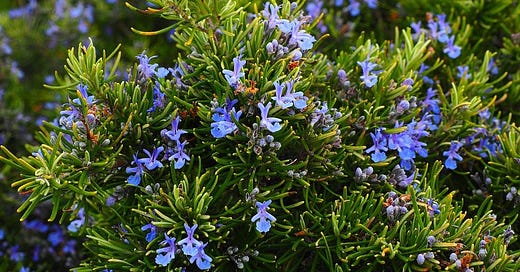Rosemary
“There’s rosemary, that’s for remembrance; pray, love, remember:"
Let’s take our first look into Ophelia’s flowers with rosemary, since it’s the first flower she hands out in Act IV scene v.
According to the language of flowers, rosemary (salvia rosamrinus), which is also known as “compass weed, incensier, [and] pilgrim’s flower” (Inkwright 133) has often been associated with remembrance and wisdom (Roux 152). Roux explains in her book Floriography that this belief actually stems from ancient Greece when Greek scholars would wear “crowns of rosemary during their examinations” (Roux 152). Inkwright explains in her book Folk Magic and Healing: An Unusual History of Everyday Plants that Greek students would “braid rosemary into their hair to help them with their studies” (Inkwright 133).
Inkwright further mentions that rosemary was often “thrown into a grave to ensure that a person would not be forgotten” and explains it’s significance in spiritual practices, such as how rosemary has been used to deter negativity and drive away evil spirits when burned, that “grown, or dried and hung by a doorpost [it] will deter would-be thieves” and that overall, it’s an herb of protection. In Ireland, Inkwright explains that rosemary was “hung to protect a child from being stolen by fairies and replaced with a changeling” and that in the Middle Ages it was scattered over floors at Christmas because “it would release its scent the more that it was walked upon” (Inkwright 133).
Roux acknowledges that the symbolism of rosemary with memory was “cemented with the help of Shakespeare” in Ophelia’s “famous ‘flower speech’” (Roux 152). It is the first of Ophelia’s flowers that she hands out to those watching her madness in Elsinore castle. Ophelia begins her speech by saying, “There’s rosemary, that’s for remembrance; pray, love, remember:" (Shakespeare, IV, v, 170-171).
Traditionally, it is Laertes whom Ophelia gives rosemary too, but different productions of Hamlet have changed who the recipients of Ophelia’s flowers are, which of course can change the meaning of her speech and characters motivations. If Laertes is being given rosemary, Ophelia may be trying to subconsciously tell her brother to remember a time before her madness and to remember their father whose death caused her madness. If Gertrude or Claudius are the recipients, rosemary could be seen as Ophelia wanting them to remember the former king, perhaps implying she knows more about how the former king died then is they think her to know. This of course also hinges on how Ophelia is portrayed, is she a mad woman communicating through her flowers or putting on an antic disposition like Hamlet and communicating in code through her bouquet?
Overall, Ophelia is telling the characters around her and the audience to remember. It is up to the audience to understand what it is she wants us to remember. Does she want us to remember who she was before she became mad? Does she want us to remember a time before Denmark was rotten? Does Ophelia want us to know that she is more aware of what is happening in the court than people think? Or is she just a young raving mad woman talking nonsensically, but surprisingly accurate, with her flowers?
So many thoughts and considerations from one small flower.
Sources
“03 - Rosemary (Salvia Rosmarinus).” Itineraris Marimurtra, 18 Aug. 2022, https://marimurtra.cat/itineraris/en/medicinals/03-romani/.
Inkwright, Fez. Folk Magic and Healing: An Unusual History of Everyday Plants. LIMINAL 11, 2019.
Limited, Alamy. “Hamlet - Ophelia with Symbolic Flowers Stock Photo.” Alamy, Alamy, https://www.alamy.com/hamlet-ophelia-with-symbolic-flowers-image504812645.html.
McClellan, Michael. “Professor Butter Beard, Ophelia and Rosemary.” Professor Butter Beard, SquareSpace, 13 June 2022, https://www.professorbutterbeard.com/blog/professor-butter-beard-ophelia-and-rosemary.
“Ophelia, Sir John Gilbert, 1817-1897 There's Rosemary, That's for Remembrance. Pray You, Love, Remember. and There ...: John Gilbert, Illustration, Illustration Art.” Pinterest, 22 Sept. 2012, https://www.pinterest.ca/pin/ophelia-sir-john-gilbert-18171897-theres-rosemary-thats-for-remembrance-pray-you-love-remember-and-there--280067670548264021/.
Roux, Jessica. Floriography: An Illustrated Guide to the Victorian Language of Flowers. Andrews McMeel Publishing, 2020.
Shakespeare, William, and Eli Reynolds. Hamlet - the Pelican Shakespeare. Penguin Putnam Inc, 2016.





